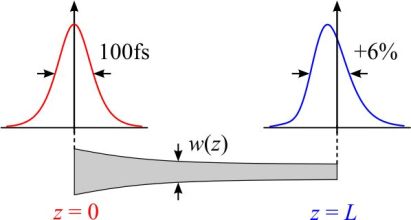
Nonlinear effects stemming from the third order susceptibility χ(3) constitute a promising mechanism for all-optical signal processing. A wide range of effects has already been demonstrated in guided-wave devices (from optical fibers to integrated waveguides), ranging from fundamental operations like self-phase modulation, spectral broadening and bistability to higher level applications like multiplexing and wavelength conversion.
Apart from intrinsic nonlinearity, semiconductor materials like silicon are the platform of a distinct type of nonlinear optical effects stemming from free carriers which are either injected or generated via two-photon absorption (TPA). Free-carrier dispersion (FCD or plasma effect) and dispersion (FCA) have been utilized in a multitude of applications in integrated silicon-based components, like absorption modulators or switches.
The efficiency of χ(3) nonlinear phenomena depends on the inherent material nonlinearity, the optical power, the effective device length and the confinement of the optical intensity. Nano-photonic technologies, like the recently proposed hybrid silicon-plasmonic waveguides, can provide extremely sub-wavelength confinement giving rise to nonlinear response in micron-sized devices while boosting or suppressing free-carrier phenomena. Finally, in recent years, the emergence of two-dimensional materials like graphene has generated attention towards their potential for nonlinear applications.
The combination of nonlinearity and optical feedback in a structure such as a waveguide resonator results in bistable behavior, in terms of the transmitted optical power. This effect offers a route towards implementing all-optical memory or switching elements. Moreover, the intensity build-up inside a highly confining nanophotonic resonator can lead to reduced input-power requirements for bistability. Another nonlinear phenomenon which can manifest in waveguide resonators under the presence of FCD is self pulsation, where a CW optical input can result in an amplitude-modulated output with a frequency of tens of GHz.
A nonlinear guided wave effect of particular interest is soliton formation, since it provides a dispersion-free format for pulse propagation. In silicon photonic waveguides the formation of pure solitons is hindered (besides linear losses) by the presence of nonlinear loss mechanisms (TPA & FCA). However, soliton-like pulses can still form in properly tapered, dispersion-decreasing waveguides. In fact, by employing a carrier-sweep bias, bit rates beyond 1.28 Tb/s are possible with virtually no pulse distortion.
References
- O. Tsilipakos, T. Christopoulos, and Em. E. Kriezis, "Long-Range Hybrid Plasmonic Disk Resonators for mW Bistability and Self-Pulsation," IEEE/OSA Journal of Lightwave Technology, 34 (4), pp. 1333-1343, (2016). [pdf]
- D. Chatzidimitriou, A. Pitilakis, and Em. E. Kriezis, "Rigorous calculation of nonlinear parameters in graphene-comprising waveguides," Journal of Applied Physics, 118, 023105, (2015). [pdf]
- A. Pitilakis and Em. E. Kriezis, "Highly nonlinear hybrid silicon-plasmonic waveguides: analysis and optimization," Journal of the Optical Society of America B, 30 (7), pp. 1954-1965, (2013).
- O. Tsilipakos, D. C. Zografopoulos and Em. E. Kriezis, "Quasi-soliton pulse-train propagation in dispersion-managed silicon rib waveguides," IEEE Photonics Technology Letters, 25 (8), pp. 724-727, (2013).
Fig. 1: Bistability curve for a NLCGS disk resonator coupled to a straight CGS waveguide. Bistable states A and A' can be accessed by points C and B.
Fig. 2: Quasi-soliton propagation along a properly-tapered silicon rib waveguide. Temporal broadening remains less than 6%.
Fig. 3: Optical confinement in nonlinear nano-photonic waveguides: (a) Si-wire, (b) Si-slot, (c) generic hybrid silicon-plasmonic.




